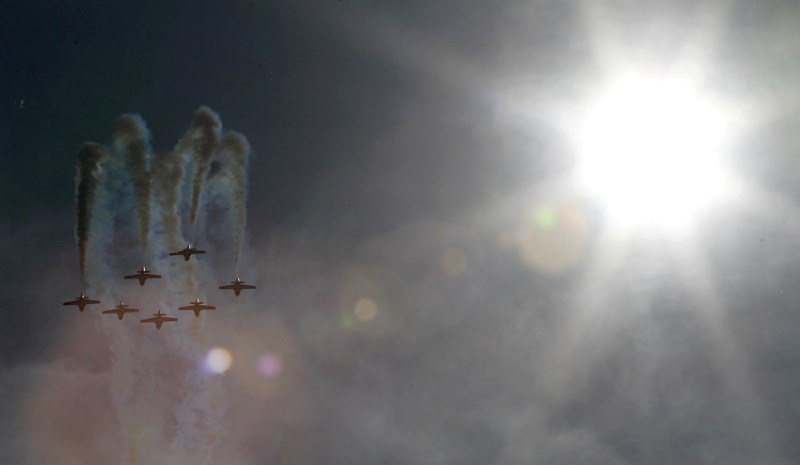They came, they blew white smoke and they went.
It’s all in a day’s work for the Canadian Forces Snowbirds.
There is, however, much more work that goes into an air show than simply arriving, providing breathtaking aerial manoeuvres and flying away in their CT-114 Tutor jets.
The average show is the culmination of one-and-a-half to two years of training and preparation as well as the elite pilots paying their flight dues before even calling themselves Snowbirds.
Beginning in 1970, the Snowbirds were born out of the Golden Centennaires, a flight group created in 1967 to commemorate the country’s centennial.
From there a permanent flight demonstration team was created and the elite military unit was officially formed. The first flight was July 11, 1971 at home base, CFB Moose Jaw.
“For many of us it’s a culmination of a life’s work and having the opportunity to be on the team is truly an honour,” said Capt. Mark Velasco, public affairs officers for the Snowbirds.
All Snowbirds’ pilots are former fighter jet or helicopter instructional teachers and have flown at least 1,500 hours before applying to the prestigious club. If accepted, a pilot serves two years before moving on.
“People get chosen based on their ability to adapt, communicate well and work as a team and rise up to a challenge,” said Velasco. “It’s the ability of each individual member to work as a cohesive unit to make the show what it is.”
The cosy fuselage shared between pilot and technician makes for close-quarters midair, but the experience of flying a truly Canadian aircraft is like no other.
“It’s kind of one of those things that those who are claustrophobic get that feeling,” said Brett Parker, second line astern in the No. 5 jet. “The cockpit is so small and crammed, but I’ve never had too many problems.”
Parker grew up in Edmonton and would routinely drag his parents to air shows within 500 kilometres of home.
“I usually tried to plan camping trips that would at least get us close to one of the locations where an air show was, too,” he said. “It’s been a childhood dream of mine (to join the Snowbirds)”
Parker graduated with his Canadian pilot wings in 2003, served as a flight instructor and flew a CF-18 fighter jet.
He tries to interact with the public as often as possible and be a positive face for the Canadian Forces.
The Snowbirds are a male-dominated group, however one woman did make a breakthrough and represented her gender for two years in the early 21st century.
Lt.-Col. Maryse Carmichael applied for the Snowbirds in the late ‘90s after serving as a flight instructor in the Canadian military at Moose Jaw, Sask. She was initially rejected but re-applied in 2000 and was accepted for the following year’s team.
“It was awesome mainly because the first time I tried out I didn’t make it,” said Carmichael, who first saw the Snowbirds as a young girl in the late ‘70s. “This was something I always wanted to do.”
Carmichael served as the No. 3 plane’s pilot in her first year followed by No. 2 the following year. She didn’t mind being the oddity on the team and said everyone was very respectful.
“Sometimes it is a bit intimidating and you’re the only woman there,” said Carmichael, a Quebec City, Que., native. “But I grew up with three brothers so they prepared me quite well for what I do now.”
It was her older brother Ed, also a military pilot, who inspired her to delve into the unique profession.
Now, she has returned to the Snowbirds as the team’s commanding officer, voted in by committee.
“For me, it’s looking at the overall operations of the entire squadron and the future of the squadron,” said Carmichael.
“We’re extremely lucky to be able to do what we do,” she said.
“People often hear about Canadian Forces in Afghanistan but you rarely get to meet them. We get to meet Canadians on a daily basis.”



